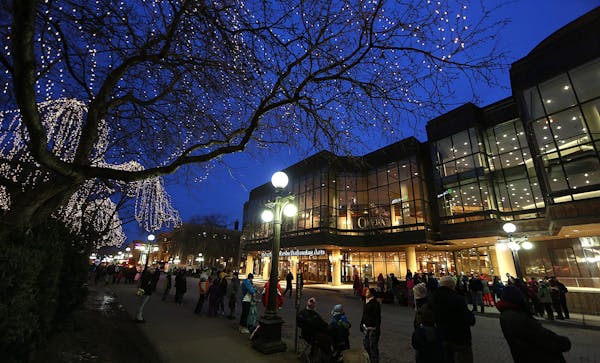Ever since Ordway Center was built 30 years ago, the musicians of the St. Paul Chamber Orchestra have not only had to perform in a one-size-fits-all theater more suited to opera and symphonies than to chamber music. They also had to contend with an overcrowded calendar, fighting for rehearsal time and concert dates with the Ordway's other tenants.
Now, like a sister who has had to share space with three siblings finally getting her own room, the SPCO is stretching out and getting comfortable in the new Ordway Concert Hall. The musicians still will have to share on occasion. But this second stage is designed especially for a chamber group's sound.
"It's the beginning of a new era," said SPCO President Bruce Coppock. "A concert hall is as much a part of an orchestra's identity as the musicians' individual instruments."
The hall also gives the SPCO much more onstage rehearsal time, and the option to increase the concerts it plays on coveted Saturday nights from 18 to 24 a year. The first concerts in the space, featuring a program of Prokofiev, Beethoven and the premiere of a string arrangement of George Tsontakis' "Coraggio," will be March 5-6.
"It's such a luxury," said Kyu-Young Kim, senior director of artistic planning. "The weeks in which we play concerts at the Ordway, we have access to rehearse in the hall all week long, when we used to have only Thursday mornings. And Saturday nights, it's our dream to play as many of them as possible."
Tailor-made acoustics
The 1,100-seat Concert Hall is smaller than the adjacent 1,900-seat Music Theater where the SPCO used to play, projecting a more intimate feeling appropriate to a chamber orchestra. Nearly every aspect of its design has an acoustic as well as an aesthetic function.
Minneapolis architect Tim Carl, who oversaw the recent renovation of Northrop Auditorium, designed the hall in the classic rectangular "shoebox" style, with minimal separation between performance platform and the audience. Unlike the Music Theater, there is no proscenium. A relatively narrow width of about 72 feet further promotes a sense of immersion. (By contrast, Orchestra Hall in Minneapolis, which seats nearly 2,100, is 92 feet wide.) Three tiers of seating include a choral loft behind the stage that can accommodate more than 100 singers or audience members.
The strikingly beautiful ceiling is made of 14 miles of mahogany-stained oak dowels arranged into undulating wooden screens. The "wavy" screens allow sound waves to fill the upper space of the hall before returning to the musicians and audience below. Acoustician Paul Scarbrough, who has designed acoustics for dozens of concert halls worldwide, added more than 1,000 gypsum wall panels varied in depth and width to temper brittleness in treble frequencies and ensure an even diffusion of sound.
To make the hall more versatile, draperies and banners can be deployed on the ceiling and side walls to dampen the acoustics for shows employing amplified music. An acoustical break between the hall and foyer allows both halls to present simultaneous performances without noise interference. A 22-inch-thick wall and double-slab roof keep out the din of 5th Street traffic.
The SPCO recently performed a "hard-hat concert" for the construction workers who built the hall and their families. Principal cellist Julie Albers said that during the concert she noticed that the acoustics bring out a "more pronounced warmth" to bass overtones.
"In rehearsal, you can hear everything so clearly, but what happens when the space is full of people gets really exciting," she said.
Albers called the new hall "revitalizing." She said, "To be able to play in this space, to hear every little nuance and work in such detail, will really help us develop our sound. And to know it's our home will do enormous things for the identity of the group."
Kim, who has been working with Scarbrough on small touches such as adding curtains and some additional materials behind the stage, said only subtle changes have been necessary during the fine-tuning process over the past month. The choral ensemble Cantus came in to test how vocals sound from the stage.
"Like anyone who's bought a new house knows, there are always variables you don't know about going in, but once you're living there you figure it out," he said. "We can play so much softer, blending the string sounds — you can hear everything on the stage."
The audience effect
"The audience will find that the SPCO is defined in their minds in a completely different way," Coppock said. "The aural experience is that much more dynamic."
The orchestra remains committed to its neighborhood concerts around the Twin Cities, so trying to accommodate more Saturdays at the Ordway is "a difficult jigsaw puzzle," he said. "But Saturday nights have an energy of their own, in large measure because the audience is rested, but also they have more of a sense of occasion."
The hall will have an anchoring psychological effect for audiences as well as the orchestra, Coppock said.
"When we embarked on this plan, we drove a stake deep in the ground," he said.
For Kim, the hall won't feel quite real until the first official concert, but "it does already feel like home."
Kristin Tillotson • 612-673-7046

Minnesota Sports Hall of Fame: A class-by-class list of all members

This retired journalist changed professional wrestling from Mankato

